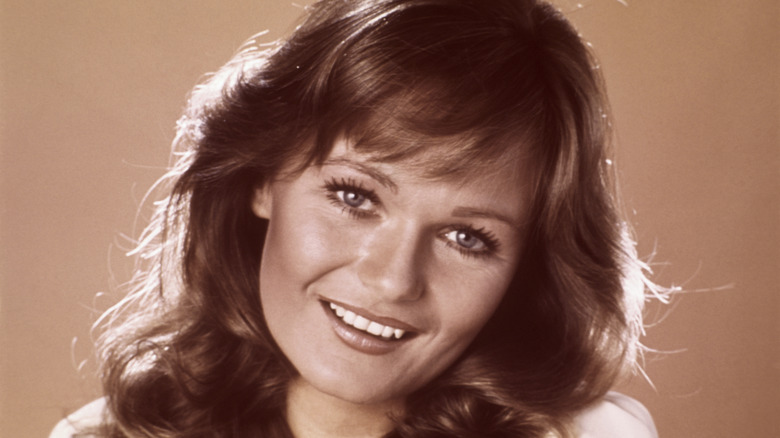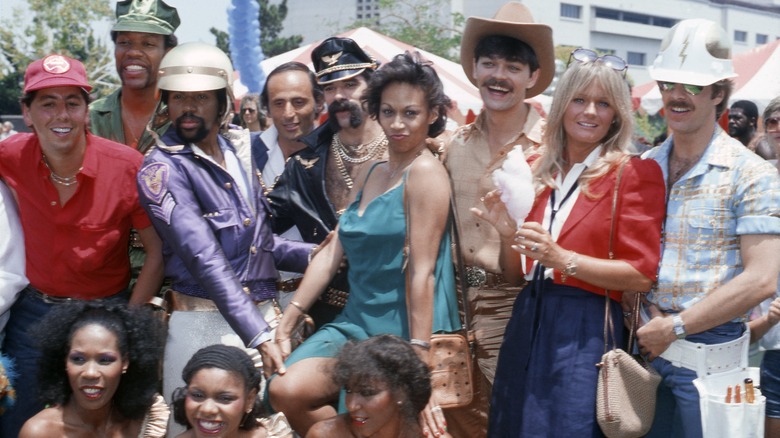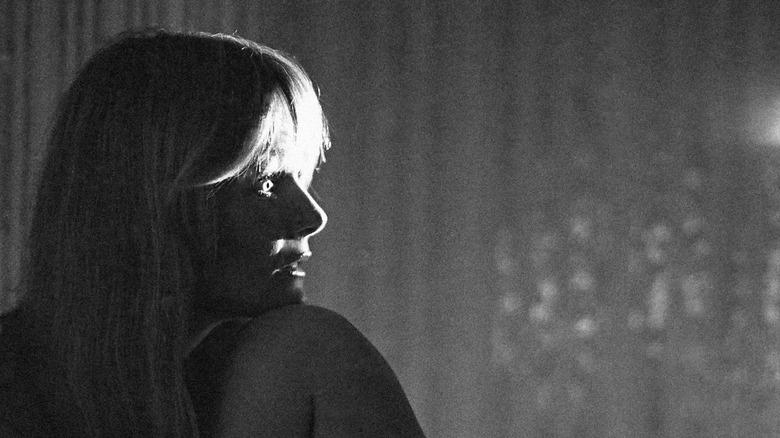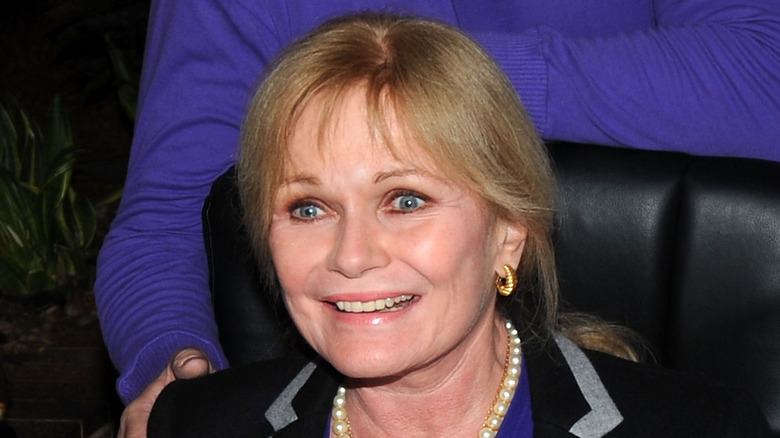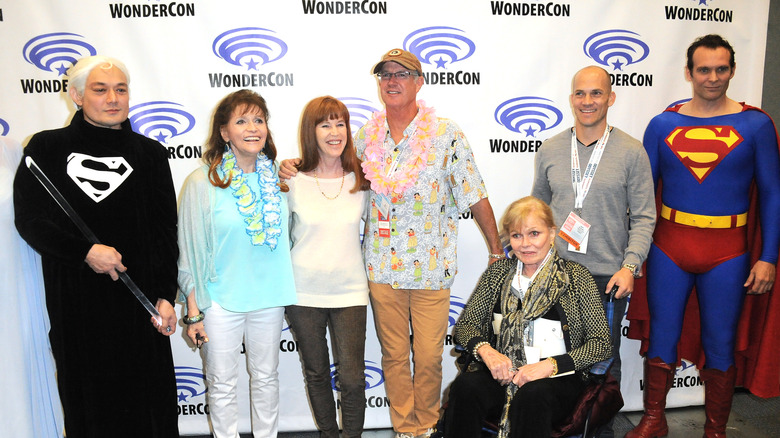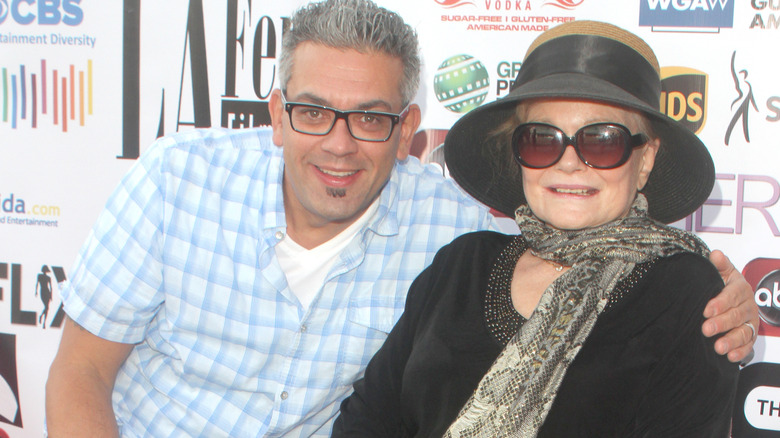Whatever Happened To Valerie Perrine?
A 1976 draft of what eventually became "Superman: The Movie" includes a character who never appeared in a Superman comic book, or any other DC title. Lex Luthor's sardonic, lovesick, and slightly dim sidekick Eve Teschmacher was thought up by the screenwriters. For a long time, screenplays and screens were the only place to find her. DC has only brought her into the comics in recent years, and her reincarnations in later Superman TV shows were in many respects far removed from her lighthearted roots. But that original portrayal has had staying power. Being in a nearly universally beloved Superman movie has helped her endure, no doubt, but credit is also due to the actress behind Miss Teschmacher: Valerie Perrine.
Perrine was riding high career-wise when she signed onto Richard Donner's "Superman." She'd been nominated for both an Oscar and a Golden Globe for her performance in 1974's "Lenny." In her personal life, she'd had two close brushes with death; a Las Vegas gig kept her from Sharon Tate's home the night of the Manson family murders. A few years later, she walked away from a plane crash with just a few cuts. For believers in the so-called Superman curse, its reach couldn't be said to encompass supporting players.
Love affairs, world travel, and the variety of show business gave Perrine a colorful run from her early days through the 1970s. The following years weren't as kind to her career, and the last decade has been hard on her health. But Perrine hasn't vanished into the night, and through her setbacks has shown more of herself than her most famous roles.
A Village People vehicle set her career back
Miss Teschmacher is often counted as Valerie Perrine's most famous role, and it was one of the last prominent and acclaimed parts she would have. "Superman: The Movie" and "Superman II" were shot simultaneously but released two years apart, with the latter undergoing major reshoots after director Richard Donner was fired and replaced with Richard Lester. Perrine was unaware of the changes made to the second film; she shot all her scenes for both with Donner and wasn't brought back. She spent the years between the releases working, and four films featuring Perrine came out between 1978 and 1980. The last to come out before "Superman II" became the movie Perrine blamed for derailing her career.
That movie was "Can't Stop the Music," a musical comedy vehicle for the disco group, the Village People. Originally titled "Discoland ... Where the Music Never Ends," it had the misfortune of being released just as the disco craze was coming to an end. An ill-advised advertising campaign also presented the sexually-charged movie as a family-friendly romp. "Can't Stop the Music" was part of the inspiration behind the Golden Raspberry Awards, and Perrine was among the nominees for Worst Actress at the first annual Razzies.
The film's failure, Perrine told The Hollywood Reporter, ruined her, but she was gracious about it at the time. "She would host glamorous parties for all of [the cast]," Caitlin Jenner remembered for the Reporter. "She was truly the hostess with the mostest and knew how to have a great time for us all."
Years of dancing wore her body out
One of Valerie Perrine's first performances, she told The Hollywood Reporter, was for the emperor of Japan. She was 4 years old, her father was stationed in Japan after World War II, and her mother had been a showgirl. Following in her footsteps, Perrine was part of a ceremonial dance that used her, sans black wig, for the finale. The family moved back to the U.S., and once she turned 17, she turned to dancing to make a living in Las Vegas during the 1960s. And she did, earning as much as $800 a week (about $8,000 when adjusted for inflation).
Perrine danced on floors and up and down stairs. She danced in heavy costumes and in topless get-ups. She put in up to 12 shows a week and was still working as a showgirl at the end of the 1960s. And by 2006, the toll all that dancing had taken on her body was undeniable. "I remember the doctor saying her body had the wear and tear of an NFL player," said director Stacey Souther, who has acted as caretake for Perrine for years, to The Hollywood Reporter. Perrine needed to undergo surgery to fuse her spine together, an operation that left her in recovery for months.
Valerie Perrine was diagnosed with Parkinson's in 2015
In 2011, Valerie Perrine began to show essential tremors, an involuntary shaking caused by an issue with the nervous system. The tremor was visible at public events, such as a "Women of Superman" panel at Texas Comic Con 2013 (via YouTube). She made light of it at the time, assuring con guests that it wasn't due to the lingering fear of heights that kept her from doing much of the flying work in "Superman: The Movie." But at one Christmas dinner, her brother, a specialist in neurological disorders, noticed that Perrine still had a tremor in her hand even while at rest. Essential tremors are exacerbated by movement, but a resting tremor is a sign of Parkinson's disease.
A positive diagnosis soon followed. To try and relieve the tremors, Perrine opted for deep brain stimulation, a procedure that uses electric currents transmitted into the brain to "interrupt the irregular signals" that cause involuntary movements for those with neurodegenerative diseases, as explained by Johns Hopkins Medicine. For several years, the surgery's success appeared to be marginal; the tremors were brought under control, but Perrine's mobility steadily declined, to the point where she now requires a hydraulic lift in the bedroom. She also developed aphasia, the same language disorder as Bruce Willis. For that, at least, Perrine has experienced unexpected relief; to the shock of her neurologist, and without a clear scientific explanation, her aphasia reversed and she was able to hold conversations again as of 2023.
She's had all her teeth replaced
As a side effect from one of her treatments to manage her Parkinson's disease, Valerie Perrine gradually lost her teeth. One of her medications made them brittle. Unable to properly eat, Perrine opted to have permanent implants to replace her lost teeth. Not only that, she consented to have the procedure documented on Inside Edition (via YouTube).
The surgery involved fitting permanent implants in four pieces onto Perrine's upper jaw. After she was sedated, her periodontist removed all remaining teeth from the top row and used bone taken from other areas of the mouth to fill the resulting gaps and shore up the jaw's strength. The doctor told Inside Edition that Perrine's bones had become so soft that it made them difficult to work with, but she was able to get what she needed to fix several screws into the jaw to secure the dental implant. A week later, when asked to review the results, Perrine declared: "It's perfect!"
She's the subject of a documentary
In 2006, Valerie Perrine met Stacey Souther, a Georgia native who came out to Hollywood looking to act. The two became close friends, and as Perrine's health deteriorated, Souther became her de facto caretaker (with some professional help). For years, he's driven her to doctors' appointments, kept her fed, entertained her at home, and works odd jobs to help support Perrine, who was left financially strapped after the 1980s (a GoFundMe started by Souther raises money to cover Perrine's Parkinson's-related expenses).
Perrine and Souther have always maintained theirs is an intimate but platonic friendship. Souther takes no money for caring for her. "Valerie inspired me," he told Parkinson's Life. When Perrine went in for deep brain stimulation, Souther considered it a "once-in-a-lifetime event" and filmed the whole thing. That footage became the kernel of "Valerie," a documentary short on Perrine's life Souther produced and directed. The film covers Perrine's life and impact on pop culture. It made it into several film festivals and picked up several awards, including the Youth Jury Award Best Documentary Short at the Rhode Island International Film Festival and Best Short American Documentary at the American Documentary and Animation Film Festival.
The awards must have been a nice bonus, but they weren't a factor in making the film in the first place. "This film is a love letter to [Perrine]," Souther told Parkinson's Life of the film. "I didn't want her to be forgotten. I wanted her life and legacy to be celebrated and shared with the world."
